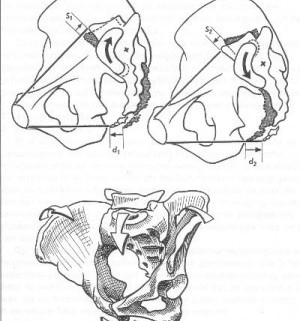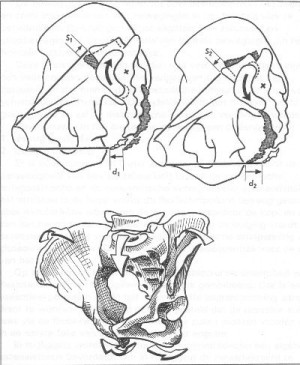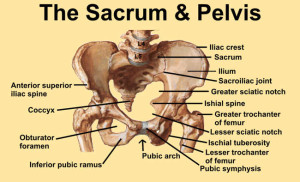Straight Talk About Movement in The Pelvis…
A brief description of how the pelvis moves:
Movement of the pelvis is derived from the complex potential of movement at the SI or sacroiliac joint and at the pubis. Because of the SI joints peanut-like shape it allows for a multitude of movements as the spine rotates and the legs move. Here are some of the basic movements:
Nutates – Anterior or forward rotation of the sacrum
Counter nutates – Posterior or backward rotation of the sacrum.
*When you flex the hip as in a plie the scrum nutes allowing for a gentle increase in the lumbar curve. When you extend the hips as in standing up from plie the sacrum counter-nutates allowing for a lengthening of the lumbar curve.*
Further resources on nutation/counter-nutation: http://www.physio-pedia.com/Sacroiliac_joint
Innominate Bones
The two halves of the pelvis can both rotate, slide up and down (lateral flexion), and forward and back (abduction/adduction) at the SI joint.
With the movement of the legs:
When the right leg is forward/loaded the right innominate rotates posteriorly and slides up on the right side (laterally flexes).
When the left leg is back/unloaded the left innominate rotates anteriorly and slides down on the left side.
And vise versa as in walking.
With the movement of the hip joint:
When the hips are flexing the superior aspects of the innominate bones (ASIS) narrow while the posterior aspects (ischial tuberosities) widen.
(This is happening in conjunction with the sacrum nutating as hips flex).
When the hips are extending the superior aspects of the innominate bones (ASIS) widen while the posterior aspects (ischial tuberosities) narrow.
(This is happening in conjunction with the sacrum counter-nutating as hips extend).
In addition:
When the hips are flexing the ASIS are also adduction slightly (narrowing anteriorly).
When the hips are flexing the ASIS are abduction slightly (narrowing posteriorly).
What the femurs do:
When the hips flex the femurs externally rotate.
When the hips extend the femurs internally rotate.
What the abdominals do:
When you flex the hips and the ASIS narrow (sitz bones widening – pelvic floor eccentrically contracting), the transversus abdominis concentrically contracts drawing the waist in and up (narrowing muscularly), and the external obliques concentrically contract.
When you extend the hips and the ASIS widen (sitz bones narrowing – pelvic floor concentrically contracting), the transversus abdominis eccentrically contracts drawing the waist back to it’s original shape (wider muscularly), and the internal obliques concentrically contract.
The conclusion:
When we flex and extend the hips as in walking the SI joint ends up “tumbling” (Reference: Eric Franklin) moving in a counter-rotating spiral like the infinity sign. This movement radiates up the spine creating additional counter-rotation between the upper and lower halves of the body.
Therefore even a “stable” pelvis, one that is well organized and can stay balanced under the spine on top of the femurs, should have movement and hence promote healthy rhythms of rotation throughout the body (including at the knee, ankle, foot, shoulder joint, head and neck).
“The slight but important rotating, sliding, gliding, and pivoting action of the sacroiliac facets serve as the singular link point where the axial skeleton is attached to the pelvis; thus the necessity of this joint being bilaterally strong and slightly mobile to adapt for biomechanical impairments deficiencies above and and below.” — Chapter 6 from R. C. Schafer, DC, PhD, FICC’s best-selling book: “Motion Palpation”
For further study of the sacroiliac joint and the movement of the innominate bones of the pelvis check out this AMAZING resource:
The Low Back Site: The Sacroiliac Joint – Richard DonTigny, PT




 How are you showing up? Why are you showing up? Why do you teach? What IS teaching? Why do you care? This is Skillful Teaching: A Whole-person approach to being an expert teacher, not an expert technician. There's a difference. Want to know what it is?
How are you showing up? Why are you showing up? Why do you teach? What IS teaching? Why do you care? This is Skillful Teaching: A Whole-person approach to being an expert teacher, not an expert technician. There's a difference. Want to know what it is?

Nice post Chantill. Looks like the pelvis is certainly a powerhouse of motion. Here is a video I like that shows how motion occurs around the SI joint. The first part of the video has the anatomy. I like it because it highlights how LITTLE but IMPORTANT movement occurs at the SI joint and makes bigger movements possible as we travel out peripherally. Enjoy.
http://youtu.be/D6NTMgWCSaU